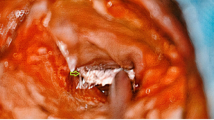Abstract
Tympanic perforations can be determined mainly by acute and chronic otitis, or ear trauma. These defects can possibly heal spontaneously. A persistent perforation represents not only an anatomical but also a functional defect, requiring surgical correction in most of the cases.
The quality of life of the patients (e.g., hearing, water sport, recurrent infections) is the main goal that guides the indication to reconstruct a tympanic membrane.
Myringoplasty (or tympanoplasty type 1) is performed using a free graft of connective tissue at the perforation site, which should act as a guide for the re-epithelialization of the eardrum. Various materials have been used during time, such as temporalis muscle fascia, tragal cartilage or perichondrium, and heterologous fascia (e.g., Biodesign Membrane®, Tutopatch®). The choice of the graft depends on the features of the perforation, the external auditory canal size, and middle ear-related findings (e.g., state of middle ear mucosa, Eustachian Tube function). This kind of surgery has been traditionally performed with the aid of an operative microscope through the external auditory canal (EAC) or the retroauricular approach. The main disadvantage of this technique is the poor control on the anterior quadrants of the eardrum, especially in case of narrow ear canal with anterior overhangs. These aspects can be quite easily managed by means of a transcanal endoscopic approach. In this approach the graft is positioned in underlay technique (i.e., under the tympanic annulus) and over the ossicular chain, in order to reduce the risk of medialization.
Thanks to the endoscopic technique, the canalplasty is seldom needed, since the whole tympanic membrane is usually seen and even the most anterior aspect of the perforation can be controlled. Nevertheless, it is a one-handed technique and an adequate training is mandatory in order to learn how to repair tympanic membrane perforations. Due to the relatively small size of the external auditory canal and the wider extension of the pars flaccida in the ovine model, the training proposed on to this model might represent a valid option to obtain surgical skills to perform this technique in human patients.
Access this chapter
Tax calculation will be finalised at checkout
Purchases are for personal use only
Similar content being viewed by others
References
Furukawa T, Watanabe T, Ito T, Kubota T, Kakehata S. Feasibility and advantages of transcanal endoscopic myringoplasty. Otol Neurotol. 2014;35(4):e140–5.
Tseng C-C, Lai M-T, Wu C-C, Yuan S-P, Ding Y-F. Endoscopic transcanal myringoplasty for anterior perforations of the tympanic membrane. JAMA Otolaryngol Head Neck Surg. 2016;142(11):1088. https://doi.org/10.1001/jamaoto.2016.2114.
Botti C, Fermi M, Amorosa L, et al. Cochlear function after type-1 tympanoplasty: endoscopic versus microscopic approach, a comparative study. Eur Arch Otorhinolaryngol. 2020;277:361–6. https://doi.org/10.1007/s00405-019-05706-z.
Fina M. Endoscopic repair of tympanic membrane perforations: an exercise of acrobatic dexterity or the sign of the beginning of a new era in otology? JAMA Otolaryngol Head Neck Surg. 2017;143(1):11. https://doi.org/10.1001/jamaoto.2016.3370.
Tseng C-C, Lai M-T, Wu C-C, Yuan S-P, Ding Y-F. Comparison of endoscopic transcanal myringoplasty and endoscopic type I tympanoplasty in repairing medium-sized tympanic perforations. Auris Nasus Larynx. 2017;44(6):672–7. https://doi.org/10.1016/j.anl.2016.12.007.
Anschuetz L, Bonali M, Ghirelli M, et al. An ovine model for exclusive endoscopic ear surgery. JAMA Otolaryngol Head Neck Surg. 2017;143(3):247. https://doi.org/10.1001/jamaoto.2016.3315.
Author information
Authors and Affiliations
Editor information
Editors and Affiliations
Rights and permissions
Copyright information
© 2021 Springer Nature Switzerland AG
About this chapter
Cite this chapter
Mattioli, F. et al. (2021). Myringoplasty. In: Bonali, M., Presutti, L., Marchioni, D. (eds) Comparative Atlas of Endoscopic Ear Surgery. Springer, Cham. https://doi.org/10.1007/978-3-030-47005-0_6
Download citation
DOI: https://doi.org/10.1007/978-3-030-47005-0_6
Published:
Publisher Name: Springer, Cham
Print ISBN: 978-3-030-47004-3
Online ISBN: 978-3-030-47005-0
eBook Packages: MedicineMedicine (R0)




